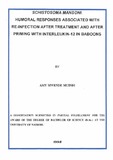Schistosoma Mansoni Humoral Responses Associated With Re-infection After Treatment And After Priming With Interleukin-12 In Baboons
Abstract
People living in schistosomiasis endemic areas, constantly get re-infected with the disease
after treatment and it is unknown what the effects of treatment are on the development of
immune responses in such situations of parasite exposure and re-exposure. Also, the
immunodulatory cytokine, Interleukin-12 (IL-12), derived from natural killer cells and B
cells has been reported in mouse studies to influence the outcome of schistosomiasis in
animals primed with it prior to infection. It exerts it's role by modifying the balance of T
cell sub-populations so that Th-I cells predominate as determined by the presence of
cytokines such as interferon gamma (INF-y), interleukin-4 (IL-4) and interleukin-5 (IL-S).
This study was divided into two parts. The first part, experiment 1, was designed to
examine the effects of treatment and re-infection on antibody responses while the second
part, experiment 2, was carried out to examine the influence of the immunodulatory
molecule, IL-12 on cytokine (IL-4 and IL-S) production in baboon schistosomiasis.
For the first experiment, baboons were given a primary infection of Schistosoma mansoni
cercariae (either single -SI or multiple -MI), treated with praziquantel and then given a
single or multiple secondary infection. That is, SVSI, SVMI, MIIMI and MIlS!. For the
second experiment, baboons were primed with ova alone, IL-12 + ova, IL-12 alone or
with saline (control) and later infected with S. mansoni cercariae. The serum samples
obtained at various time points during the course of the study were exposed to Enzyme
Linked Immunosorbent Assays (ELISAs) and the absorbance readings (40Snm) taken.
Results showed that single primary exposure to S. mansoni parasites in baboons, causes
severe pathology than multiple primary exposure, while antibody levels after re-infection
following treatment, show a modulation of the disease with relatively mild pathology
irrespective of single or multiple re-infection doses. It was also observed that, there is no
clear-cut difference between the role of IL-4 and IL- S from that of IL-12 in baboon S.
mansoni infections because they all play a role of healing, by modulating the pathology
due to the disease.
Citation
Bachelor of Science ZoologyPublisher
University of Nairobi

